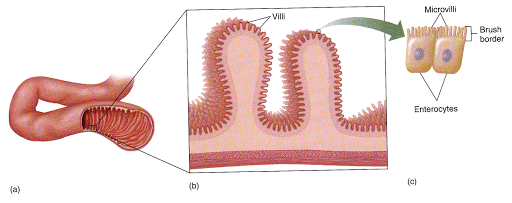The Abridged Larry the Vegan Burger Story
Larry, the vegan burger, is about to meet his destiny: your gastrointestinal tract (GI tract) and body cells. A vegan burger is a meatless burger that contains the texture and taste of meat (this is debatable). Also, it provides plenty of protein, fats, and carbohydrates. Larry must go through digestion to meet his destiny, converting him into little food pieces and monomers(amino acids, fatty acids, and simple sugars). The monomers of Larry will absorb into your blood, where your body will be using the monomers to make structural proteins, enzymes, and non-steroid hormones (proteins); energy storage molecules, steroids, and cell membranes (lipids); and short-term energy storage and cellular energy (carbohydrates). In other words, Larry is about to become one with you and your poop.
The Gastrointestinal Tract
The gastrointestinal tract, or GI tract, is a 21-foot hollow tube that extends from the mouth to the anus. It is the tract that food and drink will travel through, and undigested food will excrete from
Propulsion, Secretion, Digestion, Absorption, and Excretion
Propulsion
Swallowed food moves through the gastrointestinal (GI) tract via peristalsis. Surrounding most of the GI tract is a smooth muscle layer that produces strong wave-like contractions, called peristalsis, that propel food. Peristalsis begins in the esophagus and ends in the rectum.

Secretion
The salivary glands, pancreas, liver, stomach, and gallbladder secrete enzymes, hydrochloric acid, bile, and pancreatic juice into the GI tract. This slurry of digestive juice is critical for digestion.
Digestion
Digestion is a catabolic process. Teeth and bile break big pieces of food into smaller pieces via mechanical digestion. However, smaller pieces of food are not chemically changed. Enzymes in saliva, gastric juice, and pancreatic juice chemically digest the carbohydrates, proteins, and lipids into monomers.
Absorption
The food monomers and most water in food and drink diffuse through the small intestine lining into the blood via absorption. Most of the remaining water in the undigested food is absorbed through the lining of the large intestine.
Excretion
The distal portion of the large intestine compacts the undigested food and remaining water into feces. The feces is excreted during defecation (pooping, number 2, making the bathroom uninhabitable).
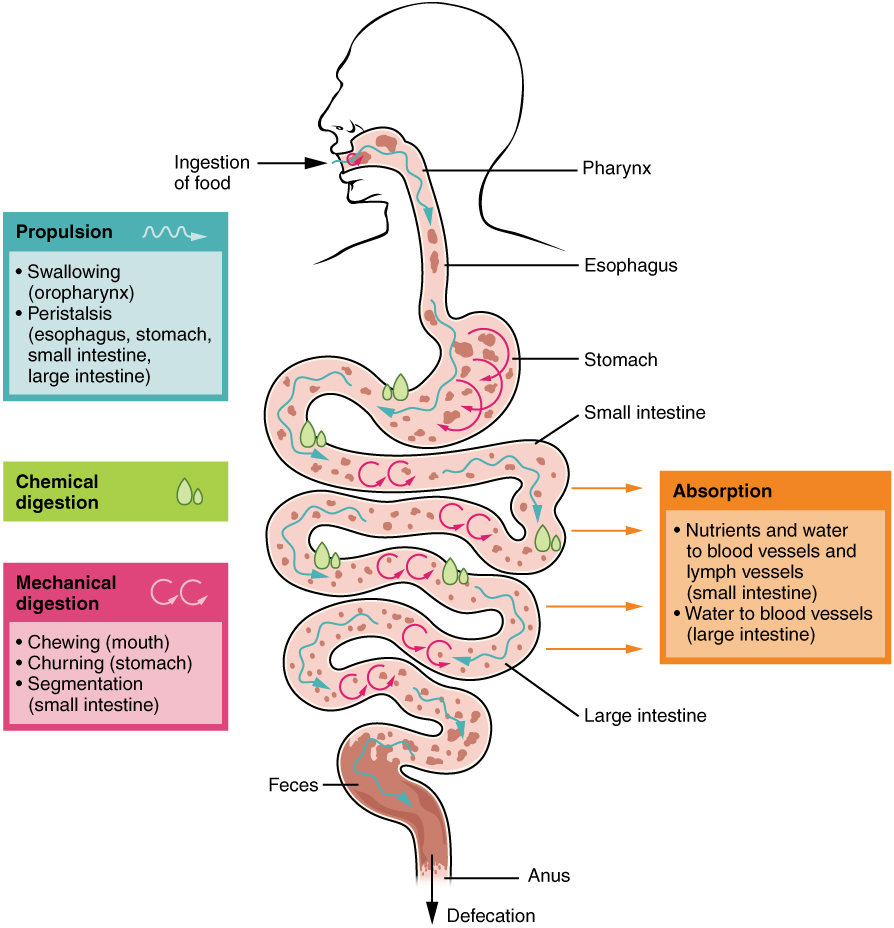
The Unabridged Larry the Vegan Burger Story: Journey Through the GI Tract
The Oral Cavity: Where Digestion Begins
Digestion begins in the mouth where the enzyme amylase in saliva catabolizes (digest) the starch in Larry’s bun and patty into simple sugars. The teeth cut and smash Larry into smaller pieces, and the tongue rolls him into a moist ball called a bolus.
The Esophagus: Where Peristalsis Begins
Larry, the bolus, is swallowed and moves down the esophagus towards the stomach via peristalsis. A circular valve-like smooth muscle called the cardiac sphincter (aka the lower esophageal sphincter) surrounds the esophagus’s distal portion, which acts as a door separating the stomach from the esophagus.
Gastroesophageal reflux disease, or GERD, occurs when the cardiac sphincter does not work as it should and acid bubbles into the distal esophagus. The nonkeratinized stratified squamous epithelium that lines the esophagus is not designed to protect against strong acids, so the stomach’s acids burn the esophagus’ epithelium. Prolonged exposure to the stomach’s acid will lead to an esophageal ulcer. A proton pump inhibitor is the usual GERD treatment because it reduces the amount of H+ (protons) in the stomach, which raises pH.
| This is the Condition GERD | This is a GERD Concert | This is the Giantess GERD |
|---|---|---|
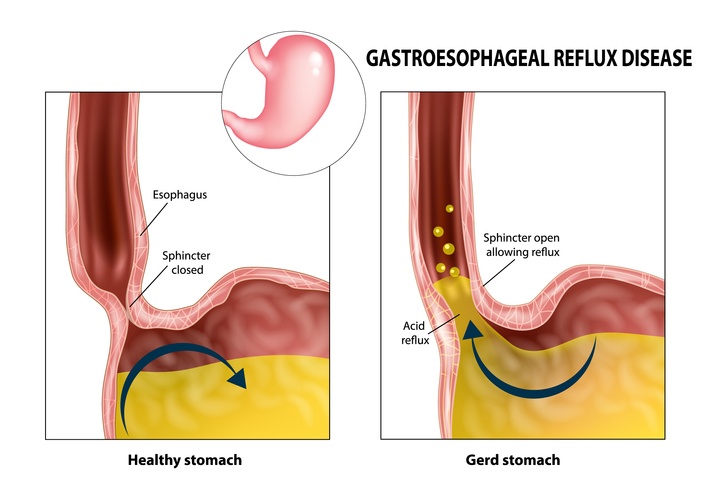 | 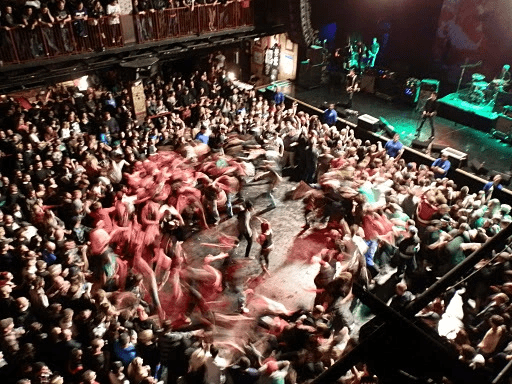 |  |
The Stomach: Where Protein Digestion Begins
The cardiac sphincter opens, and Larry, the bolus, falls into a pit of hydrochloric acid, mucus, and enzymes known as the stomach. The hydrochloric acid kills pathogens on Larry and converts the proto-enzyme pepsinogen into the active enzyme pepsin. Pepsin chemically digests Larry’s protein into amino acids. The smooth muscle contractions in the stomach walls churn and mechanically digest Larry until he becomes a viscous solution called chyme.


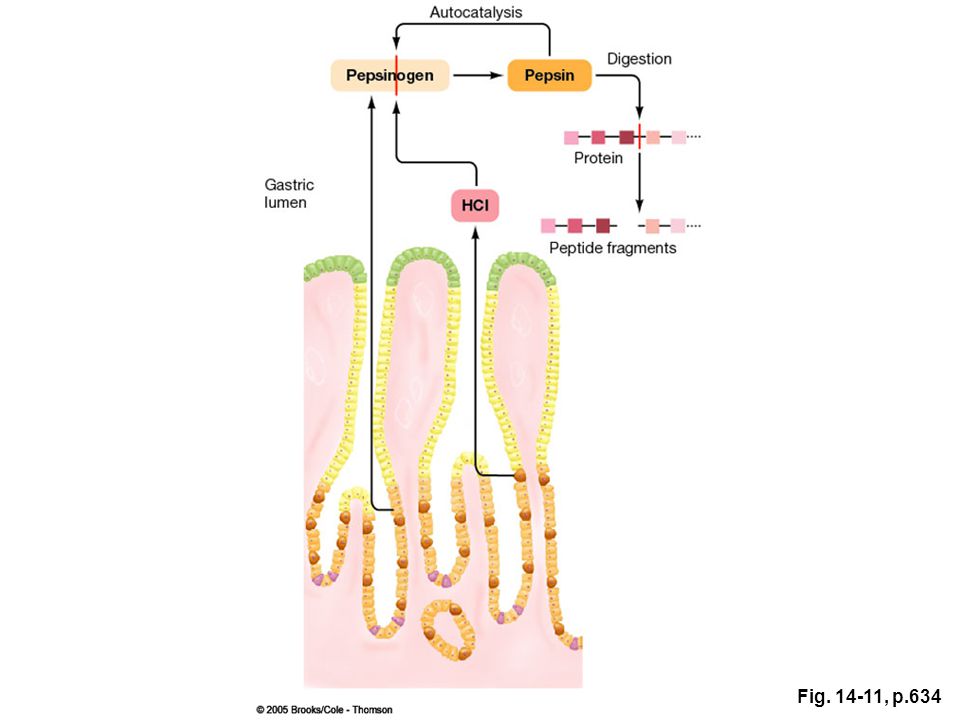
It’s Not a Tumor! It’s an Ulcer!
Many goblet cells within the stomach’s epithelium secrete mucus to protect the simple columnar epithelium from the acidic and enzyme-rich chyme. An ulcer (an open wound) will form if the acid comes in contact with the stomach wall. The bacterium Helicobacter pylori is the cause of most stomach and duodenal ulcers. H. pylori weakens the mucus in both the stomach and duodenum, making it more likely that the acidic chyme will contact the epithelial tissue, causing an ulcer.
Spicy food and stress do not cause ulcers; however, both can aggravate an existing ulcer. The only “food” that can lead to an ulcer is alcoholic beverages since alcohol thins the gastric and intestinal mucus.
A detail explanation an H. pylori infection can lead to an ulcer
Warning!!!!!!!! The video above shows an ulcerated stomach.
The Small Intestine: Where the Majority of Digestion and Absorption Happens
The Duodenum
Larry, the chyme, leaves the stomach through the pyloric sphincter and enters the small intestine’s proximal portion, the duodenum, where he meets a slurry of bicarbonate ions, bile, and digestive enzymes. The bicarbonate ions (HCO3–) raise the acidic chyme (Larry) from a 2 to pH 6 or 7, so the chyme causes an ulcer or denatures (destroys) digestive enzymes.
The pancreas secretes a digestive juice into the duodenum that contains the majority of enzymes that will chemically digest Larry the chyme into monomers gut bacteria will digest the rest), and the liver secretes bile that emulsifies(a type of mechanical digestion) large fat droplets into baby droplets.


Borborygmus
Definition – A rumbling or gurgling sound caused by the movement of gas in the intestines.
When your intestines make that rumbling sound, you can say, “Wow, my intestines are very borborygmus today.” It’s been 30 years since I have been a high school student, but I am pretty sure saying this will make you the coolest student on campus.
Pancreatic Juice and Bile Secretion
So how does the pancreas “know” when to secrete its enzyme slurry? How does the gallbladder “know” when to secrete bile, and how does the liver “know” when to make bile?
Good questions. I was hoping you’d ask these questions.
Well, I aim to please.
The short answer is hormones.
Great. More hormone talk. Let me guess: there is some sort of feedback loop involved.
Yep. Wanna hear it?
No.
It will be on the quiz.

It’s interesting.

Yes. So, digestion involves many different hormones, but we will only discuss two. Both hormones are a part of positive feedback loops.
- Duodenal cells secrete secretin when the acidic chyme enters the duodenum.
- Secretin tells the pancreas to secrete a slurry of bicarbonate ions.
- The bicarbonate ions enter the duodenum through the pancreatic duct, increasing the chyme’s pH from 2 to 6/7.
- The fats in the chyme trigger the hormone cholecystokinin (CCK) release. CCK tells the gallbladder to secrete bile and the liver to make bile.
- Carbs, lipids, and proteins in the chyme also trigger the release of CCK. CCK tells the pancreas to secrete its enzyme slurry into the duodenum
- As more chyme enters the duodenum, it triggers the release of more secretin and CCK.
- The positive feedback loop continues until the chyme’s pH is neutral and enough enzymes and bile are needed to digest the chyme.
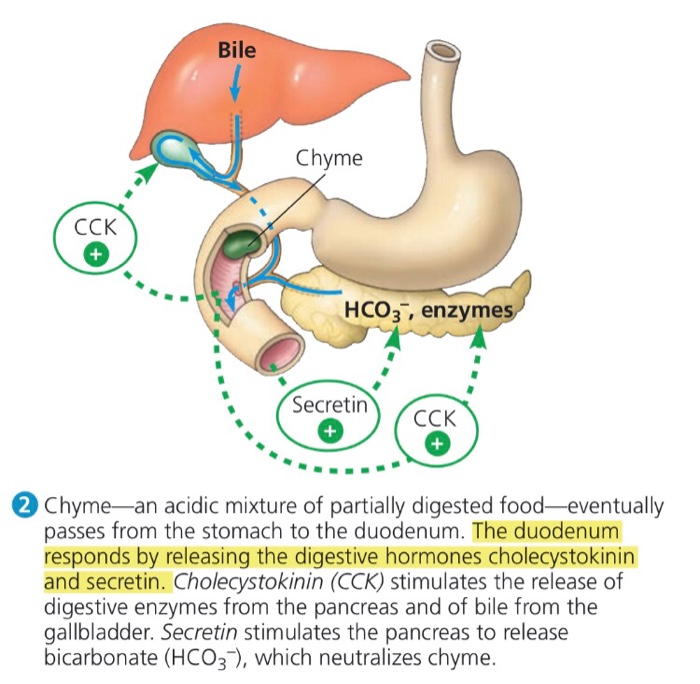
Interesting, right?

Fun With Fiber
You cannot digest plant fiber because humans do not make the enzymes or contain the gut bacteria that can chemically digest fiber.
So, why do we need it?
Well, fiber slows digestion, which reduces a spike in blood glucose. It contains vitamins and nutrients, and it makes poop soft so it can smoothly move through the GI tract. Fiber also acts like a sponge and removes some LDL cholesterol (bad cholesterol) from the blood.
The Jejunum and Ilium
After Larry, the chyme, is digested, he moves to the jejunum and ileum, where Larry’s monomers and water will move into the blood. The small intestine is the most extended segment of the gastrointestinal tract; however, it has a smaller diameter than the large intestine. Therefore, the width, not the intestine’s length, determines its size (large or small).
Microvilli
Knock, knock.
Who’s there?
Microvilli?
Microvilli who?
Microvilli increase the surface area of the small intestine’s lining to the size of a tennis court to ensure adequate digestion and absorption of food.
The wall of the small intestine consists of valleys and hills called villi. The epithelial cells that line the villi have microvilli on the side facing the free surface. The villi increase the small intestine’s surface area by 30 fold, and the microvilli increase the surface area by 600 fold, which increases the rate and amount of digestion and absorption of food and water. The small intestine is about 15 feet long and has a one-inch diameter. If the small intestine did not have villi and microvilli, its surface area would be about 49 square feet. However, the villi and microvilli increase the small intestine’s surface area to a whopping 2,700 square feet, about the size of a tennis court.
Gluten, the Enemy of Microvilli
About one percent of the population has celiac disease. Celiac disease is an autoimmune disease that occurs only when gluten (a major protein in wheat) is present. Gluten causes the immune system to attack and destroy the microvilli in the small intestines, decreasing digestion and absorption of food. Gluten can also lead to the inflammation of the gallbladder and pancreatic duct in those with celiac disease. The good news is a diet devoid of gluten can reverse the damage caused by celiac disease.
On a side note, most people who think they are gluten intolerant usually are not. Only a blood test and biopsy of the duodenal wall can determine if a person has celiac disease.
The Large Intestine: Home of the Gut Microbiome
The remaining undigested food moves into the large intestine through the ileocecal valve(sphincter). The large intestine is shorter than the small intestine but has a larger diameter. Most of the remaining water in Larry, the undigested food, diffuses into the blood through the large intestine walls.
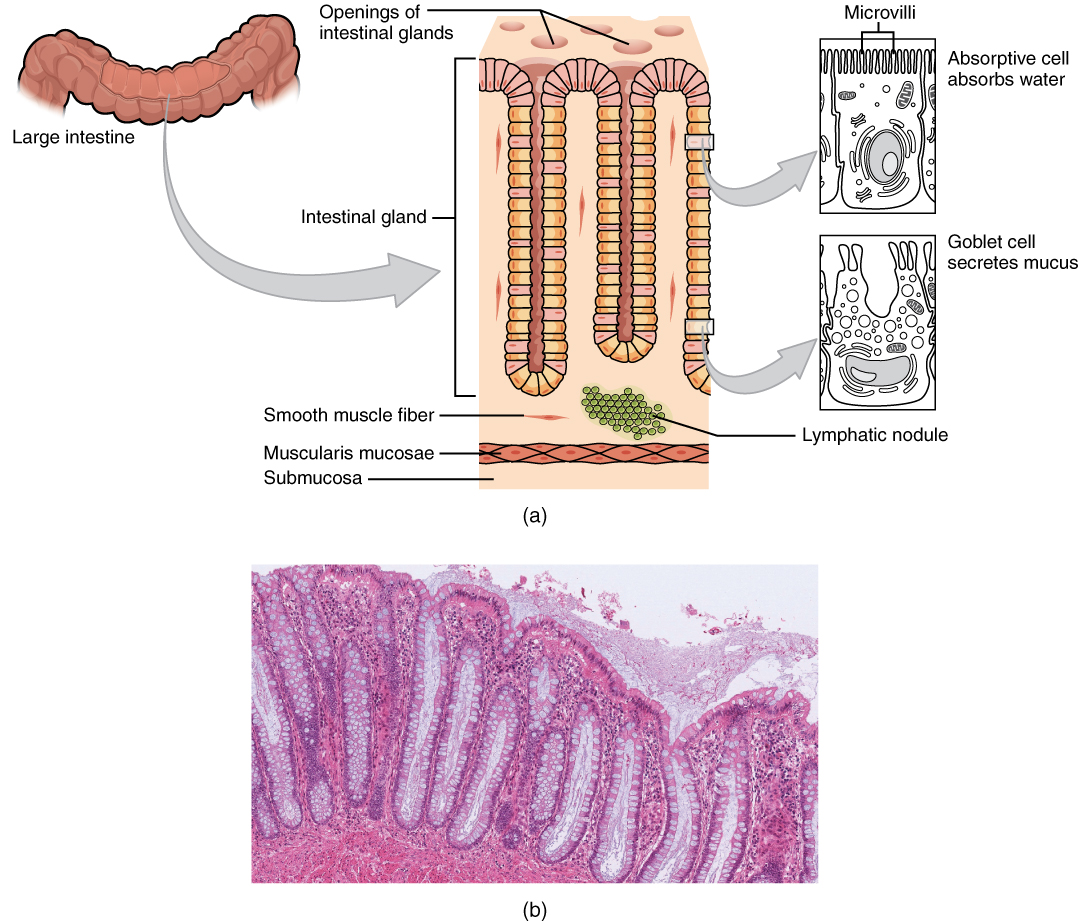
The large intestine is home to trillions of bacteria that comprise your gut microbiome. How gut bacteria affect our physiology is still relatively unknown, but we know we cannot survive without them. For example, certain gut bacteria synthesize vitamin K, aiding blood clotting.
The Rectum
After absorbing most of the remaining water in the undigested food, it solidifies and moves into the rectum. The distal end of the rectum is surrounded by the internal sphincter, followed by the external sphincter. The internal rectal sphincter consists of involuntary smooth muscle that, when stretched, produces the urge to defecate. The external rectal sphincter consists of voluntary skeletal muscle that controls defecation. When the sphincters open, Larry, the feces, exits the gastrointestinal tract through the anus.



